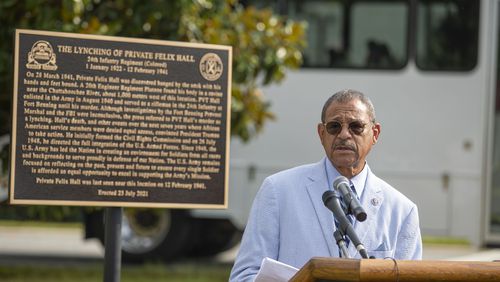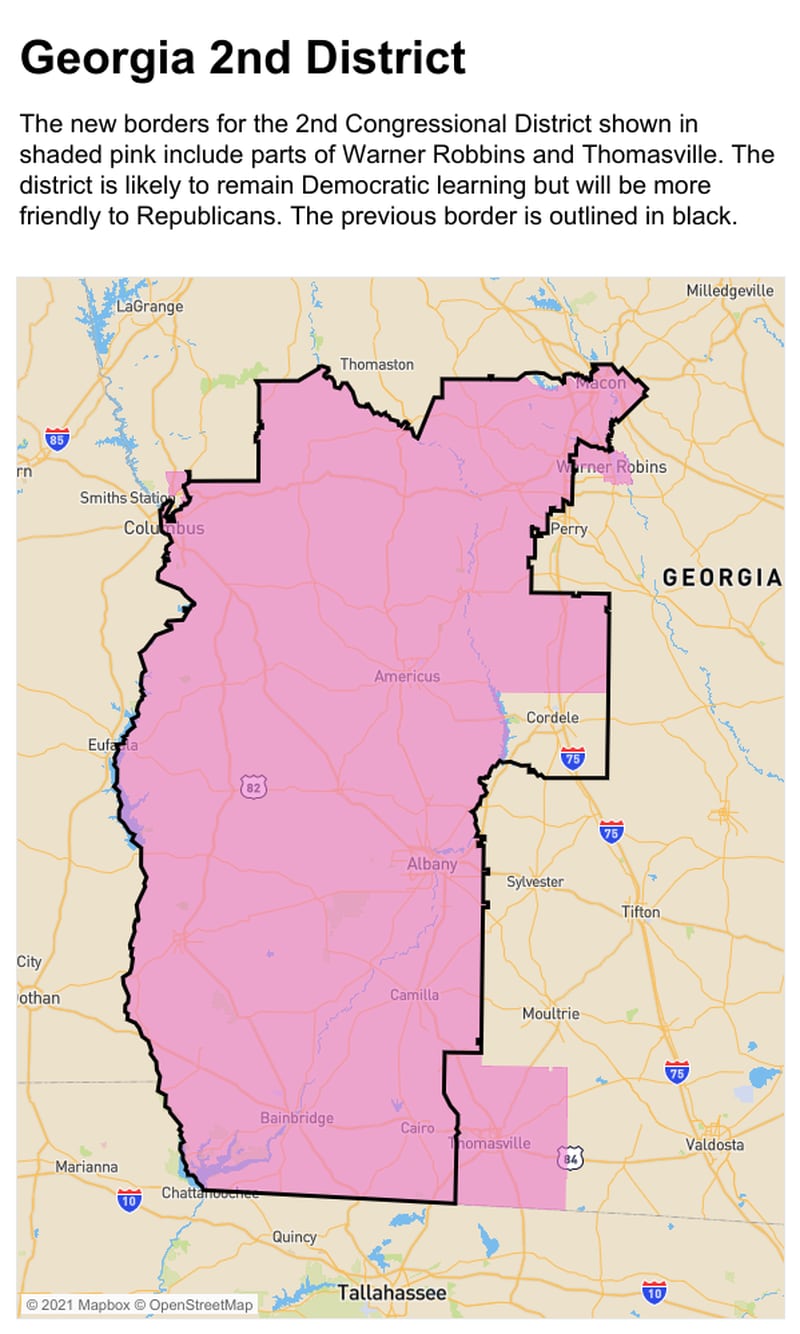The new lines drawn for the 2nd Congressional District in southwest Georgia have Democrats on edge that the long-held seat could be lost, especially if incumbent U.S. Rep. Sanford Bishop retires.
The district, even in the short term, would remain Democratic-leaning. But Republicans say the numbers are turning in their favor and they’re confident they can flip the seat.
“It’s winnable,” said Brandon Phillips, the 2nd District GOP chair. “I think this is the year to win it in, and I think the trend going forward gets even better.”
Because of population shifts in Georgia that saw people moving away from rural areas and toward its cities, the 2nd District needed to expand to ensure it had the target number of 765,136 voters.
The map drawn by the Republican-led General Assembly, which Gov. Brian Kemp is expected to sign into law, shifts the district’s boundaries into Thomasville and Warner Robbins and removes voters in Cordele.
The old district was 51% Black in 2020, the same as when the lines were drawn in 2010. The new district drops slightly to 49% Black.
Credit: Isaac Sabetai
Credit: Isaac Sabetai
Between 2010 and 2020, the white population in the 2nd District dropped from 42% to 39%. It rises slightly to 40% in the new map.
Still, Democrats are expected to carry the district at least in the short term. The Atlanta Journal-Constitution has projected that a generic Democrat would beat a generic Republican by 10 points.
Bishop, an Albany Democrat who has held the seat for 28 years, said he wasn’t concerned after an initial review of the new boundaries because he didn’t note much difference between the old lines and the new.
“In the new district, as well as the old district, we have agriculture, we have three metropolitan areas: Macon Columbus, Albany,” he said. “We’ve got military bases with lots of veterans in both iterations. We have colleges and universities, private and public. In both iterations, we’ve got communities of interest that are well represented. I think that that seems to be fair.”
Bishop said he “absolutely” plans to run for reelection and believes voters will send him back to Washington.
But that hasn’t kept some of his supporters from sounding the alarm.
Dougherty County Democratic Party Chair James Williams said Republicans, who control the redistricting process in Georgia, were trying to dilute the strength of Black voters by making the district less-Black.
“We are very concerned,” Williams said. “It’s going to affect people of color.”
Williams said he and other party leaders are already gearing up for a lawsuit to challenge the new congressional map, as well as changes made to state House districts in the area.
The number of Republicans showing interest in challenging Bishop is another indication of the impact of redistricting.
Two candidates have submitted paperwork and begun raising money: Tracy Taylor, chairwoman of the Dougherty County GOP, and Vivian Childs, another party activist who ran for the seat in 2020 but lost in a close primary. Thomasville attorney Chris West and William Crozer, a veteran political operative and lobbyist who worked in the Trump administration, are also considering bids.
Wayne Johnson, a former student loan official in the Trump administration, also announced two weeks ago that he was entering the race. He described the new map as the tipping point on his decision.
“It became apparent to me that it was in essence a coin-toss-type district,” the Macon resident said. “It could wind up going Democrat, it could wind up becoming Republican.”
The Republican Party’s campaign arm for House races recently added Bishop to its list of vulnerable Democrats it will target going into 2022. The group released a new ad Thursday tying Bishop to rising prices and encouraging voters to call his office to express their disappointment.
”If he’s smart, he’ll retire,” Camille Gallo, a spokeswoman for the committee posted on Twitter alongside the video.
Although Bishop has faced challengers in recent years, he has always won handily.
He carried the district with 59% of the vote in 2020 against Republican Don Cole, which was similar to his margin of victory in 2018. In 2016, he got 61% of the general election vote.
Wane Hailes is president of the Columbus NAACP and publisher of a local newspaper aimed at the Black and Latino communities. He said he wasn’t surprised to see the 2nd District shift after redistricting.
“We’ve been expecting this from Republicans for a long time,” he said. “Republicans have been trying to run against Democrats and it’s really never worked. Now it is an opportunity for them to make a change, and obviously they drew the lines so it would be a little more competitive if they decided to run.”
Hailes notes that the district remains “majority-minority” because most of its voters are nonwhite. And he said the key to keeping the congressional seat in Democrats’ control is focusing on education and turnout.
“So, is there concern? Yes,” he said. “But the bottom line is I am not sitting around crying, ‘Woe is me.’ We do need to push forward and continue to get people ready to vote despite the roadblocks they put in front of us.”









